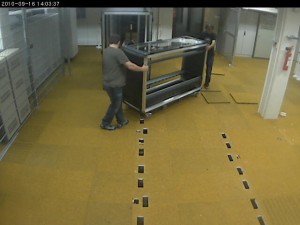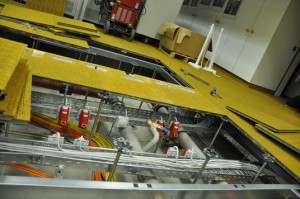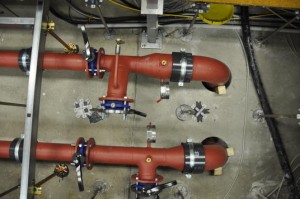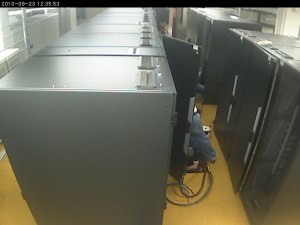Vorarbeiten
Rechnerzuwachs klingt doch recht bescheiden, aber so sind wir eben. Dennoch ist am RRZE seit Wochen eine deutlich erhöhte Betriebsamkeit und Bautätigkeit zu beobachten. Es werden dicke Wasserrohre (15 cm Durchmesser) geschleppt und vom Keller bis in den ersten Stock verlegt und zusammengeschweißt, die Decken durchlöchert (Kernbohrungen mit bis ca. 25 Durchmesser für die Kaltwasserrohre inkl. deren Isolierung), neue Stromleitungen (Kabel mit ca. 5cm Durchmesser) verlegt und Vorbereitungen für einen neuen Trafo getroffen, der Doppelboden in Teilen des Rechnerraums verstärkt, etc. — nicht zuletzt wurde zuvor bereits der ehemalige Medizinbereich im Rechnerraum freigeräumt und auch einige ISER-Stücke mussten für die HPC-Installation weichen (finden aber z.T. in anderen Bereichen des Rechnerraums wieder Unterschlupf).

... bis auf 5 Paletten war der gesamte Inhalt des Lasters für uns -- aber es war nicht der einzige LKW, der mit harter Ware für uns vorgefahren ist.

Anlieferung der Racks. Überall wo jetzt noch Löcher in den Bodenplatten zu sehen sind, werden Racks stehen.
Seit einer Woche Rollen nun schon immer wieder LKWs mit IT-Equipment an; inzwischen dürften es mehr als 60 Paletten mit Rechenknoten, Servern, Festplatten, Netzkomponenten, vielen vielen Kabeln, Racks und Kühleinheiten gewesen sein — so 5-10 Tonnen dürften da schon zusammengekommen sein.
Möglich wurde all dies durch einen Forschungsgroßgeräteantrag, zusätzliche Mittel von einigen Lehrstühlen und auch noch Restmittel aus dem Konjunkturpaket-II (letzteres speziell auch für diverse Bau-/Infrastrukturmaßnahmen), etc. …
Der neue HPC-Rechner wird LiMa heißen
- Das Akronym LiMa entstand zunächst durch die Abkürzung zweier Leuchtturmprojekte aus dem Forschungsgroßgeräteantrag.
- Wikipedia hat für Lima (mit kleinem “M”) auch viele Optionen zu Auswahl:
Angefangen von der Hauptstadt Perus und weiterer Städte weltweit (geographische Angaben sind ja durchaus beliebt zur Benennung von IT-Dingen, vgl. nicht zuletzt Intel/AMD-Prozessoren),
… über die malaysische/indonesische Zahl “fünf” oder die tibetische Bezeichnung für eine aus mindestens fünf verschiedenen Metallen bestehende Legierung zur Herstellung von Statuen und Glocken (wir haben mindestens fünf zentrale Bestandteile: Rechenknoten, Hochgeschwindigkeitsnetzwerk, paralleles Filesystem, Software und Stromversorgung/Kühlung)
… bis hin zum Buchstaben “L” im ICAO-Buchstabieralphabet. - Nachdem der LiMa-Cluster aber etwas größer wird als TinyBlue, verglichen mit großen Clustern (z.B. JuRoPa am JSC/FZ-Jülich) aber noch klein ist, kann LiMa auch für Little Machine stehen. Hieran erkennt man die fränkische Bescheidenheit. Obwohl LiMa zum Zeitpunkt der Inbetriebnahme der leistungsstärkste Rechner (bezogen auf die Peak-Performance und wohl auch die Linpack-Leistung) sein wird und mit seinen 63.8 TFlop/s Peak einen (kleinen) Vorsprung vor dem HLRB-II mit 62.3 TFop/s hat, erscheint “SuperFranke”, “SuperERL” oder gar “SuperFranconianAdvancedCluster” (in Anlehnung an SuperMUC, dem aktuellen Beschaffungsprojekt am LRZ) unpassend und übertrieben …
Mal abwarten, welche Erklärung sich für das Akronym letztendlich durchsetzen wird …
Zurück zu den harten Fakten des LiMa-Clusters
Im Rahmen eines europaweiten Ausschreibungsverfahrens wurde die HPC-Lösung mit dem besten Preis-Leistungsverhältnis bestimmt, wobei das Gesamtbudget vorgegebenem war. Neben der Menge der Hardware spielte dabei insbesondere auch die zugesicherte Leistung für einen typischen Erlanger Applikationsmix eine zentrale Rolle. Neun Firmen haben Ende Mai gültige Angebote abgegeben. Als Gewinner der Ausschreibung und somit Lieferant des LiMa-Clusters ist NEC hervorgegangen (Link zur NEC-PRessemeldung).
Der jetzt installierte Cluster stammt aus der NEC LX-2400 HPC-Cluster-Serie und umfasst:
- 500 Rechenknoten mit jeweils zwei Intel Xeon 5650 Prozessoren (6-Core Westmere 2,66 GHz), 24 GB DDR3 RAM, QDR-Infiniband, ohne lokale Festplatte; jeweils 4 Rechenknoten sind dabei in einem 2U hohen Gehäuse untergebracht (“Twin2”); insgesamt sind es also 6000 (physikalische) Rechenkerne und knapp 12 TB (verteilter) Hauptspeicher
- paralleles Filesystem (NEC LXFS = auf Lustre-Basis) mit 120 TB Nutzkapazität auf rund 180 Festplatten (inkl. RAID6-Parity-Platten und Hot-Spare-Platten) und einer aggregierten Bandbreite von 3 GB/s zur kurzfristigen Ablage von Simulationsdaten
- QDR-Infiniband-Netzwerk mit vollständiger Fat-Tree Topologie ohne Ausdünnungen
- 11 geschlossene Racks mit beigestellten Kühleinheiten (=> Rechenknoten); 3 offene Racks (=> Netzwerkkomponenten, Storage, Login- und Managementserver)
- CentOS 5.5 als Betriebssystem, torque/maui als Batchsystem, …
Aktueller Stand der LiMa-Installation
Die NEC-Mitarbeiter kämpfen derzeit noch fleißig mit dem Verlegen der Kabel (insgesamt knapp 2000 Stück; insbesondere die Infiniband-Kabel sind dabei auch noch unhandlich dick) …
Auch die Kaltwasserverrohrung vom Keller bis hoch in den Rechnerraum im 1. OG ist noch nicht vollständig fertiggestellt.
Die Arbeiten gehen aber grundsätzlich zügig voran. Die erste Inbetriebnahme wird jedoch trotzdem noch ein paar Tage auf sich warten lassen — rechtzeitig vor der Frist für die Einreichung zur nächsten Top500-Liste, die im November veröffentlicht wird, sollte jedoch alles laufen. Nicht dass wir auf den Linpack-Wert besonders scharf sind, aber es schadet sicherlich nicht, wenn Franken mal wieder im vorderen Mittelfeld der Top500 sichtbar ist …
Auf die Frage, wann denn der reguläre Benutzerbetrieb beginnt, gibt es eine sehr einfache FAQ-Antwort: wenn alles fertig ist und stabil läuft. Nicht früher und auch nicht später. Weitere Fragen nach einem Termin erübrigen sich damit hoffentlich.
Komplementäre Ergänzung durch TinyFat
Parallel zu LiMa wurden in einem weiteren gekühlten Rack dicke Knoten für Anwender mit hohem Hauptspeicherbedarf beschafft und durch das RRZE installiert:
- 17 Knoten (HL DL385G7) mit jeweils zwei 8-Core AMD MagnyCours Prozessoren (2,3 GHz), 128 GB Hauptspeicher und ebenfalls QDR-Infiniband
- 1 Knoten (HP DL580G7) mit vier 8-Core Intel Nehalem EX Prozessoren und 512 GB (=0.5 TB) Hauptspeicher
TinyFat — der Ursprung für den Namen dürfte klar sein — geht in den Betrieb, sobald die Kühlung der Knoten sichergestellt ist, d.h. die Kühleinheiten mit Kaltwasser aus der zentralen Kälteversorgung verbunden sind.
Betriebsende für (weitere) Teile des “Cluster32” steht bevor
Bereits im vergangenen Jahr musste der älteste Teil des alten Cluster32 (“Transtec-Cluster”) mit den snode0xx-Knoten für TinyBlue weichen. Nachdem jetzt insbesondere mit LiMa so viel neue Hardware gekommen ist, wird in den nächsten Monaten wohl der nächste Teil des “Cluster32” außer Betrieb genommen werden. Insbesondere die beiden Racks mit den snode1xx-Knoten sind nach über 5 Jahren Betrieb nicht mehr wirklich auf der Höhe der Zeit, obwohl die Knoten durchaus noch immer gut ausgelastet sind. Neun (seit der letzten Abschaltung evtl. auch ein paar mehr) der ursprünglich einmal 64 Knoten mit je zwei “Nocona”-CPUs (d.h. der ersten Generation von Intel NetBurst-Prozessoren mit “EM64T”) sind aufgrund von Hardwaredefekten sowieso bereits aus …
2009 ist also die 32-bit Ära bei uns mit der Abschaltung der snode0xx-Knoten zu Ende gegangen, 2010 wird mit der Abschaltung der snode1xx-Knoten dann auch noch die Single-Core-Ära für HPC@RRZE beendet werden. Willkommen im reinen Multi-/ManyCore-Zeitalter
Details zur Abschaltung werden aber noch rechtzeitig folgen.


